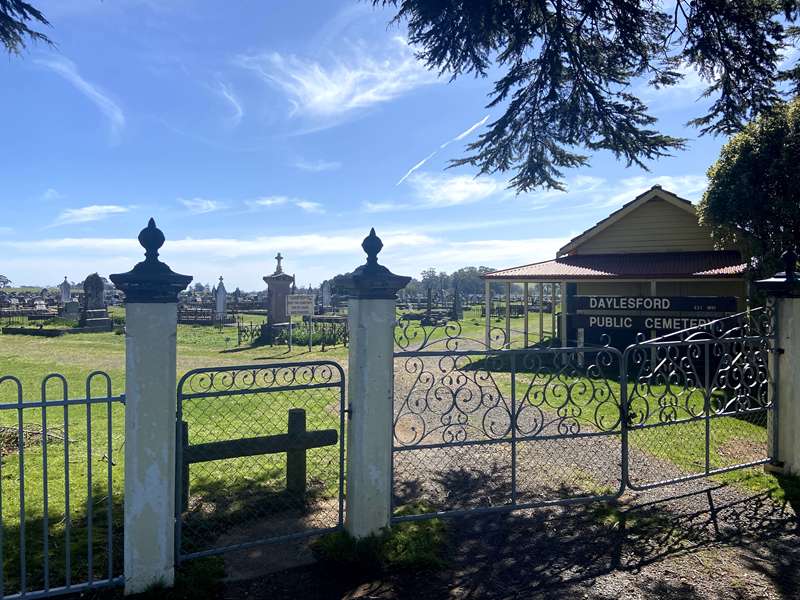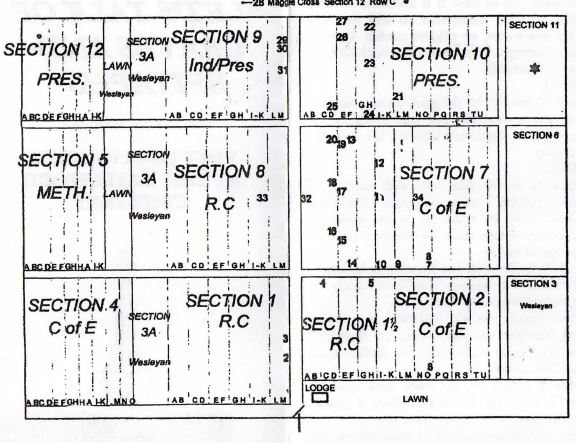Daylesford - Visit the Pioneers at Daylesford Cemetery


"Let's talk of graves and epitaphs" - William Shakespeare
Why would anyone want to wander around a graveyard looking at headstones? Some would see this as a morbid hobby, yet amateur historians and family researchers learn a lot, and develop a fascination with the final resting place of their forebears. The Daylesford Cemetery his the added advantage of having many founders of the town buried quite close to each other, making searching easier.
Map of Plots

SECTION 1
It is indicative of Daylesford's history that the first 3 impressive monuments we see in Section 1 are of:
1. John Lavezzolo, builder of the Victoria Hotel in Vincent St.
2. Jean Kelle, a Frenchman, who owned a hotel at Eganstown.
3. Pietro Foletti ran the Jockey Club Hotel, near the entrance to Victoria Park.
SECTION 1 1/2
4. Dr Guscetti (Row E) was Swiss and one of the 1st doctors on the Jim Crow Goldfield.
5. Lawrence Dyer (Row H) was another hotel owner from Glenlyon, who was also active in fanning.
SECTION 2
6. Robert Knox (whose lichen-covered headstone is barely readable at the end of the row) was one of the first members of Daylesford Council, and an early teacher at the Church of England school. He is buried with his wife, his son who died tragically at the age of 19, and his mother-in-law Sarah Bird.
SECTION 7
7. Emma Pryce lies in a neglected grave in Row O. She was the wife of the Church of England minister, and died in childbirth in 1861. She was one of the founders of the Daylesford Benevolent Society, which still exists today.
8. John William King is also in Row O. He was born in Daylesford in 1858 and became a successful businessman and councillor.
9. George Patterson was very influential in Daylesford affairs. He ran many businesses and survived many setbacks. He was prosecuted for arson & libel, but found not guilty. He was once declared insolvent, but went on to create another successful career as an auctioneer. He was also a mayor of the Borough of Daylesford.
10. Henry Bleakley's unobtrusive grave is in Row I. He was the owner of the Commercial Hotel in Vincent St, where many Mining Companies had their offices. He was also an early councillor.
11. This is the vault of the wealthy Stanbridge family. (Row I). William Edward Stanbridge was one of the first settlers, whose land surrounded the cemetery. He made a fortune from the gold under his land. (One lead runs directly under the cemetery). He lies with his wife Florence, who died giving birth to their only child (also buried here). His father-in-law Richard Colles, the sheriff of Castlemaine is also in this crypt.
12. John Goodwin Howe was a leading farmer in the district and built the produce store which the Central Springs Inn occupies today.
13. William George Hart was Town Clerk for many years, as well, as clerk or secretary of many town committees, including the Cemetery Trust. He was Registrar of Births Deaths & Marriages.
14. James H Wheeler (Row F) made a fortune from saw-milling. He was also an early councillor and became a member of the Legislative Council and Victorian Minister for Transport
15. Margaret Graham lies in an unmarked grave. She was 17 and newly married when she was murdered in 1865. At her funeral her mother threw herself onto the grave, vowing revenge. Her grave is near the Hassan family grave.
16. Francis Rotanzi (Row D) was Swiss-Italian, and was was secretary of the Yandoit Franklin Roads Board, which later became the Shire of Mt Franklin.
17. William Prohasky (small brass plaque at ground level) was a Hungarian patriot who was a store-owner and champion of miners' rights. He was also an early councillor in the 1860's.
18. Mateo Benussi (Row D) ran a Bakers shop in Daylesford's main street in the 1860's.
19. Dr McNicoll was for many years a hard working doctor and the town Coroner, presiding over many inquests.
20. Walter Smith came to Daylesford from Castlemaine and was the first Australian born person to become Mayor of Daylesford. He was another influential hotelier.
SECTION 10
21. Andrew Cross (Row L) was a reporter for, and later proprietor of the 'Daylesford Advocate' in the 1880's and 90's.
22. In Row H lies Robert Forrest, a stonemason who is distinguished by carving his own tombstone.
23. Donald McLeod, the "uncrowned King of Daylesford", was Town Clerk for many years. Elected to State Parliament, he became Minister of Mines and Water, and is held responsible for the rejuvenation of mining in Daylesford in the early 1900's.
24. Goodsir Fowler was a pioneering farmer at Porcupine Ridge. He won many prizes at Agricultural Shows for his wheat
25. Neil and Jessie Leggatt (Row D) built the large hotel still standing on the edge of Lake Daylesford, near the Boathouse Cafe. Jessie is also remembered for her contributions to St Andrews Church in Camp St.
26. In Row E is the Memorial to the Three Lost Children. A large (unsuccessful) search was organised when the children wandered away from their home in Connell's Gully in the winter of 1867. Their bodies were found the following September in Musk.
27. At the north end of Row E is the lichen-covered headstone of Peter Millar, with his wife and one child. He was a Scot, an original council member, the first Borough mayor and ran a large Drapery business in Vincent St.
SECTION 12
28. In Row C lies M M (Maggie) Cross, sister of Andrew, also a journalist and part owner of the local newspaper. Daylesford Museum has a Maggie Cross display.
SECTION 9
29. In Row M is the first wife and children of renowned builder, George Clayfield. The dates show how short life could be on the goldfields. Clayfield married three times, his first two wives dying at age 26 and 28.
30. Thomas Verey (Row M) was the town undertaker in the 1860's. This business is still in the family today, and still bears the Verey name
31. Matthew Jenkin was the operator of a quartz-crushing machine on the corner of Raglan & Vincent Sts. He is buried with his mother-in-law Rebecca Wellington.
32. On the way out via the main path (back in section 7 Row A) is Frank 'Tilley, a leading farmer and founder of the Glenlyon township.
33. Thomas Connell also rests in an unmarked grave in Section 8, Row K, Grave No. 24. He was one of the discoverers of the Jim Crow goldfield and was rewarded by the State Government. He was besieged by 'friends' after receiving this money, and as a result of this and a serious accident, he grew depressed and took his own life.
Produced by Daylesford & District Historical Society
Review:
There is a picnic table near the entrance. It is fairly easy to find the graves using the map above with numbers.
Photos:
Location
Knox Street, Daylesford 3460 View Map









